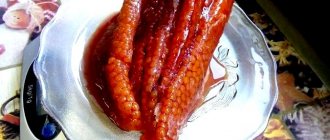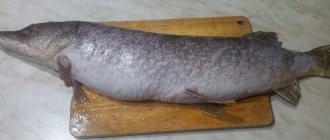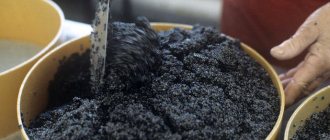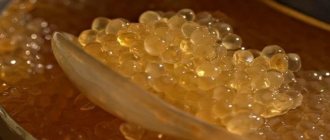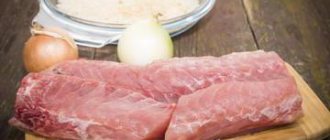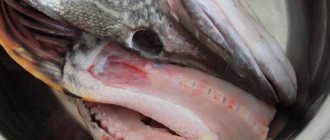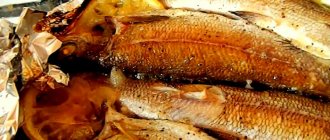Ingredients and equipment for salting caviar
Pike with caviar
For salting, we need the caviar itself, or pike with caviar and some tools.
Main ingredients:
- Pike caviar;
- Table or sea salt;
- Sunflower oil (not in all recipes).
What kind of pike caviar is there?
Pike caviar comes in different grain sizes depending on the degree of maturity. Considering that pike spawns earlier than other types of fish, the caviar of any winter pike can be considered suitable for salting, and coarser caviar is obtained from pike caught in January - February. In March, pike can already begin to spawn (pike spawning begins immediately after the reservoir is cleared of ice, still in cold water, but closer to the shore, at a temperature of 3-6 °C).
Inventory:
- Dishes for cleaning, and what to salt pike caviar in;
- Device for cleaning caviar (knife, fork, whisk, grater, colander, sieve).
As a device for cleaning caviar, you can use a knife, a fork with teeth bent in different directions, a grater, a whisk, etc. There are many ways to clean caviar; we will look at them separately.
Hot salting of pike caviar
This salting recipe came from the north; the Yakuts prepare almost any caviar using a similar method. Pike caviar cooked using the hot method is less salty than when cooked using the cold method. It is just as tasty, but due to the peculiarities of salting it turns out lighter and thinner. Hot cooked caviar can be stored for no more than 3 days.
The proportions are as follows:
- caviar – 500 g;
- salt – 2 tbsp. l.;
- water – 1 l;
- vegetable oil – 2 tbsp. l.
Preparation:
- Pour water into the pan and add salt. Salted water must be brought to a boil. To prepare caviar, the liquid must be at least 80 degrees. Usually the liquid reaches this temperature in 10 minutes.
- Pour pre-cleaned and washed caviar into boiling water. The pan must be kept on the fire for at least 5 minutes, the caviar must be stirred constantly.
- After cooking, the cooked caviar must be placed on cheesecloth. The product should lie for about 10 minutes so that the water drains and the caviar cools down.
- At the end, add vegetable oil and beat until foam appears. This is necessary for the caviar to thicken.
- Place the finished product in a clean jar and remove excess foam. The jar is tightly closed and then put in the refrigerator.
- In the refrigerator the product will infuse and be finally salted. With the hot cooking method, caviar will be ready after 6-7 hours.
Preparing for salting. Caviar cleaning
Carefully clean and gut the pike, being careful not to touch the gall bladder or damage the shell of the caviar. We leave the caviar bags to prepare for cooking, and wash the pike and send it for filleting for minced meat for making fish cutlets.
It is very important to clean the shell of pike caviar without damaging the caviar itself, but this is not so easy to do. The film of the sacs is very thin and breaks easily, and the eggs are quite small. Nevertheless, this must be done as carefully as possible - the appearance of the finished caviar, its consistency and taste depend on this.
If from the description it is not entirely clear to you how to clean pike caviar or how to salt it, do not worry, all the described processes and recipes are demonstrated in the videos that accompany this material.
There are many ways to clean pike caviar using various devices. Here are some of them:
- Using a kitchen knife, squeeze out of the shell in small portions;
- Pike caviar is broken using a fork with tines bent in different directions;
- Using a whisk by hand or with a mixer, the film remains on the whisk;
- Pike caviar is rubbed through a grater or a sieve with a large mesh, the film remains in the hands;
- Passed through a meat grinder with dull knives - the film is wound around the knives.
After pike caviar is cleaned using one of the described methods, it must be washed and filled with water, the remaining traces of the shell must be removed - the film floats up, and the caviar remains at the bottom. Moreover, depending on the recipe, cold or hot water is used.
After cleaning and washing the caviar, you need to get rid of the water - the caviar is placed in a strainer and left for a while. Now it should look perfect and you can already pickle the pike caviar.
How to salt pike caviar at home in brine?
The recipe is quite simple, because it allows you to eat the product much faster than in the previous version.
Ingredients:
- 1 liter of water
- 0.5 kg caviar
- 100 g salt
Recipe:
- Free the caviar from bags and films according to the above method. Caviar should be as dry as possible when cooking.
- In a separate container, boil water, add salt, stir until dissolved.
- Cool the saline solution to 70 degrees, set aside and wait
- Now you need to pour the resulting solution into the caviar and mix thoroughly
- Leave the product standing on the table in this state for 40 minutes.
- Take gauze, pour the contents of a colander onto it and squeeze out
- Water with a weak saline solution. Transfer the prepared product into jars and pour in a little vegetable or olive oil.
- Place in the refrigerator for 2 hours. After this time, the product can be tasted
- It goes well with black bread and butter and will complement any dish.
Pike caviar
The delicacy is prepared simply and quickly, and will be an excellent option for breakfast and snack.
Benefits and harms of pike caviar
In terms of culinary properties, pike meat has not gained much recognition among lovers of fish dishes, but it is excellent for making cutlets. Pike is not a boneless fish, so the best way to process it is to mince it. Unlike pike meat, its caviar, in terms of taste, ranks first among the caviar of other fish species that do not belong to the salmon and sturgeon families (red and black caviar).
Due to the high content of easily digestible protein, pike caviar has high nutritional value. The benefit of pike caviar also lies in the fact that it contains a large amount of omega-3 unsaturated fatty acids, which are necessary for the normal functioning of many body systems.
Omega-3 fatty acids are of particular importance in the normal growth of children and increased life expectancy. They are needed to protect the body's cells from destruction and contribute to their restoration. These acids strengthen overall health, preserve youth and beauty.
Vitamins A (retinol) and E (tocopherol), contained in pike caviar, are needed to maintain immunity, normal hair and nail growth, and skin rejuvenation. Pike caviar helps the nervous system, relieves stress and fatigue, and is considered an aphrodisiac. Contains a sufficient amount of iodine necessary for normal functioning of the thyroid gland.
Unlike salmon caviar, pike caviar has almost no contraindications. The exception is individual intolerance. Not indicated for children under 3 years of age. Excessive consumption of pike caviar is harmful; it is better to eat it more often, but in moderation.
The danger of pike caviar
Pike are carriers of many fish diseases and parasites. Some of them pose a danger to human health, one of which is diphyllobothriasis, a disease caused by a parasite. Eating raw caviar carries the risk of infection.
The risk of infection when eating caviar can be eliminated only by following the cooking rules - heat treatment of the caviar and long-term aging in a saline solution.
How to pickle pike caviar: a classic recipe
There are several pickling options. This is the preparation of prepared caviar with the addition of salt, as well as salting in brine. That is, in a strong saline solution. Salting without preparing brine is the easiest way. But before you taste the caviar, you will have to wait a few days. Because it takes quite a long time to prepare caviar according to this recipe.
Ingredients:
- 0.5 kg pike caviar
- 100 g salt
- 100 ml vegetable oil
Recipe:
- Clean the caviar from films using any of the methods described above.
- It is necessary to squeeze the product so that it is dry and pour into an enamel or glass container
- Pour salt into the caviar and rub thoroughly. This must be done for a long time, until the salt crystals completely dissolve
- This will take approximately 20 minutes. Next, pour half of the vegetable oil into the mixture and continue to grind
- It is necessary to rub until a white film appears on the surface of the product.
- Transfer the contents of the container to a jar, pour the remaining vegetable oil on top
- The pickling is placed in the refrigerator for 5 days, after which you can try the delicacy
Fishing ethics
There is an opinion that you need to take larger pike and release small ones. Indeed, a large female pike (“mother”) brings much more eggs than several smaller females, together equal in weight.
However, studies show that a very small number of medium-sized pikes survive to weigh 5 kg - one per thousand kilograms. You will do a great job to replenish the pike population if you release such a female. Remember - the pike is a reservoir orderly!
You should also take into account fishing standards, which differ for regions, and the timing of fishing bans. Regardless of the rules established by law, follow the main thing - do not take more fish than you need.
How to extract caviar from pike?
The fish is first washed well and freed from entrails. The bags filled with caviar, called yastyki, are carefully removed. Before salting, caviar is freed from the eggs, cleaned of film, blood and anything that is not caviar. You can carry out the cleaning procedure using several simple procedures:
- The yastyki can be scrolled in a meat grinder. But this method has its pitfalls. The film from the yokes is sometimes simply wound around the screw of the meat grinder; it will have to be disassembled and cleaned. It may happen that the film is crushed into small pieces, which will subsequently need to be removed for a long time.
- Connoisseurs sometimes use a mixer to quickly extract caviar. With this method, the film remains on the blade of the device, from where it cannot be removed.
- You can use a grater to extract eggs. The yastiki are rubbed on the largest holes of the grater, the films themselves remain in the hands and are thrown away.
- Rubbing the bags through a sieve gives the same result.
- There is another fairly simple but effective method. For it you need to prepare a fork, a colander and a lot of water. All available bags are placed in a basin, the volume of which is three times larger than the caviar placed in it. Then the basin is filled with boiling water. Gently stir the contents of the bowl with a fork for about 5 minutes. During this time, the films will dissolve and rise to the top. Remove any floating films with a spoon and drain the boiling water. The bowl with caviar is then filled with cold water, mixed and the water is drained again. This manipulation is repeated many times, sometimes up to 15, until all the films are washed and the water becomes clearer.
Then, after cleaning the caviar, it should be passed through cheesecloth. The gauze is laid in several layers and placed at the bottom of a colander. The piece of gauze should be large enough to accommodate the entire caviar. Next, pour in water with caviar and wait until the water flows out. The gauze with caviar is wrapped and carefully squeezed out. After this, the caviar is ready for further processing. It is very important that there are no side inclusions left in it.
